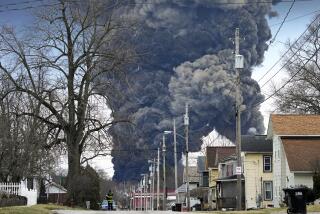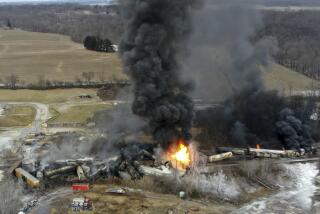ATTACK ON AMTRAK : Buckeye--The Little Town That Could : Derailment: Dozens of denizens of the small town pitched in to rescue victims. Volunteerism is ‘like an obligation that’s passed down,’ one says.
- Share via
BUCKEYE, Ariz. — If there is a moral to the massive rescue effort that was mounted in the dead of night when Amtrak’s Sunset Limited derailed in a remote spot in the desert, perhaps it comes from police dispatcher Pat Borree: “People shouldn’t underestimate small communities.”
Borree, 40, was working the graveyard shift when she got the call early Monday morning and had to respond to a tragedy of unknown dimension at a spot that even locals find hard to pinpoint.
In the end, the rescuers got the severely injured to hospitals within a matter of hours. And much of the credit must go to the grit and calm shown by Borree and other residents in this down-at-the-heels farming community of 5,000 people about 30 rocky miles from the site of the derailment.
Volunteers--teachers, farmers, salesmen, even the local newspaper editor and a local preacher--from the Buckeye Rural Fire Department were the first rescue workers to reach the site after a flurry of helicopters. As the multi-agency effort swelled to 150 people, a third were from Buckeye Rural Fire.
Borree and dispatcher supervisor Velma Washington took the lead in a full-out mobilization of law enforcement agencies, fire departments, ambulance and rescue companies and helicopter companies in the minutes after the 1:52 a.m. emergency call from the Maricopa County Sheriff’s Department.
Buckeye farmers were rousted from their beds to be ready to use their grading equipment to widen the gravel-covered roads to the disaster scene. Army and Marine bases were notified. Helicopter fueling stations were alerted.
“Buckeye is the kind of place where people still come running when their neighbor needs help,” said Sharon Butler, editor/publisher of the Buckeye Valley News and a volunteer with the Fire Department.
Butler, like other volunteers, answered a page about 2 a.m. from William David Lanford, district chief of the Buckeye Valley Rural Volunteer Fire District. After spending hours at the crash, helping to remove the injured and comfort the terrified, she went to work and wrote a front-page story.
By four-wheel-drive vehicle, Lanford reached the scene shortly after 2:30 a.m. Helicopters were arriving, but there was little light. Buckeye ladders were used to pluck train passengers from the toppled cars.
“If the moon hadn’t been full, it would have been real trouble,” Lanford said. “Our first rescues were strictly moonlight. Buckeye people know how to work by moonlight.”
Volunteerism has a long tradition in Buckeye, where the Pima cotton fields come right to the edge of the tiny commercial district, with its faded collection of stucco-fronted stores.
“Every farmer worries about his barn catching fire,” said Buckeye native Karen King, 39. “Knowing you have somebody there to help makes it easier.”
“Being a volunteer isn’t something people do just for fun,” said hardware store clerk John Fuller, 20. “It’s like an obligation that’s passed down from father to son.”
The biggest commercial outlets in Buckeye are the John Deere distributor and the Western Wear store. Downtown Phoenix is only 30 miles east on Interstate 10, but the cultural divide is a chasm. Unemployment is 11% and numerous stores are closed here, but the crime rate is low and the schools are safe.
“We’re not Camelot, but we’re not hell, either,” said Police Chief Harry Bishop, whose tiny office contains a saddle, a Native American blanket on the wall and several cowboy paintings.
“Everybody knows everybody in Buckeye, and everybody talks about everybody else--real small-town stuff,” said waitress and fire volunteer Kelly Sattlemaier, 21.
Until the derailment, the hottest news in Buckeye had been the cancellation of the annual Hellzapoppin’ Rodeo Parade and Street Fair, a staple since the 1930s, because the pro rodeo association decided to dump Buckeye in favor of a more lucrative date in Phoenix.
Bishop, 58, a gregarious Missouri transplant who teaches karate and judo, runs a 17-officer department that patrols a 104-square-mile area. His department--with its motto “Glad to be here, proud to serve”--has a zero-tolerance policy toward graffiti vandals and other miscreants. But the approach is by-the-book.
“We don’t do any Mark Fuhrman stuff here,” he said. “Things are what they are in Buckeye.”
Two years ago, the town librarian was murdered. A suspect with bloody shoes was arrested hours later on a bus to Las Vegas. He now resides on Arizona’s Death Row.
Even as the residents of Buckeye savored the fine showing of their Police Department and rural fire volunteers in the rescue effort, there were signs of defensiveness at the notion that the saboteur might be living among them.
“I don’t think we have anybody in Buckeye who would go out there and mess with something like that,” said barber Fernando Carrera, 63. “If we had somebody like that here, somebody would know him. You couldn’t hide in Buckeye.”
More to Read
Sign up for Essential California
The most important California stories and recommendations in your inbox every morning.
You may occasionally receive promotional content from the Los Angeles Times.










